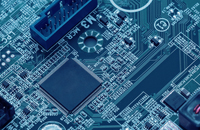- Ameya360 Component Supply Platform >
- Trade news >
- Motor Maker Revs Up for IoT
Motor Maker Revs Up for IoT
A startup designing a new kind of smart, networked motor provides a view into the state of the Internet of Things. So far, Software Motor Company (SMC) has found that lowering costs through integrated designs may be one key to success in an IoT market that has not yet lived up to its hype.
SMC makes switch magnetic reluctance motors that it claims are more efficient and reliable than traditional inductance motors. It currently sells a 5-horsepower motor for five- to 15-ton HVAC systems that draw nearly half a building’s energy use. Test customers include national retail grocery and restaurant chains and biomedical and professional offices.
“We have seen energy reductions of 50% and more in HVAC systems with our motors … we also are working with a number of OEMs to eliminate gearboxes and replace mechanical complexity with our advanced software-controlled motors,” said Ryan Morris, SMC’s executive chairman.
The key to the new motor is a custom inverter. It adjusts current about 20,000 times per second to generate the three-phase magnetic field that drives the motor.
“What’s really tricky is determining the position of the rotors in flight relative to the coils … You need to know where the rotor is to within half a mechanical degree of rotation,” said Trevor Creary, SMC’s chief technologist and a veteran designer of computer chips for Broadcom and the former Sun Microsystems.
A 200-MHz TI Delfino C2000 DSP does the heavy lifting, running algorithms and firmware that SMC’s engineers spent 18 months developing. The work required collaboration from specialists in motor control, magnetics, finite-element analysis, and power electronics. The design also uses a custom power module from Semikron.
One of the DSP’s two cores handles external communications over Modbus or other protocols to a separate SMC industrial controller. The controller uses an embedded TI ARM Cortex-A8 processor to track sensor data from the motor and the HVAC system.
SMC struck a deal with Tridium to embed its Niagara management software in the controller to monitor and control the motor and HVAC. “You shouldn’t have to be a firmware programmer to write flow-control programs,” said Creary.
Customers like the dashboard that the controller provides, but they chafe at the costs of a separate industrial controller. In addition, the controller talks over wired or Wi-Fi links to a third-party LTE gateway, typically sourced from carriers, that comes with a data plan.text
The magnetic reluctance motor uses six coil windings to define its three phases.
SMC is about to deploy a version of its inverter that can manage the sensor data, eliminating the need for a separate controller for some users. It also plans to embed an M.2 LTE module in a future controller to save the $300 cost of the industrial-grade cellular hub.
Creary said that he is evaluating modules from Quectel and Sierra Wireless that seem to provide the ruggedness, Linux drivers, and low cost that he needs. He sees 4G as overkill, given that the controllers send, at most, a few 255-byte packets per second when they are diagnosing a complex fault.
So far, SMC has not explored its cellular options, but it is focused on cost and “whatever the module vendor’s volume point is,” he said.
A report out this week said that the emerging narrowband-IoT (NB-IoT) version of LTE will represent half of the 1.3 billion low-power, wide-area (LPWA) connections worldwide by 2025.
NB-IoT made up less than 5% of all LPWA links last year but is rapidly catching up to alternatives such as LoRa and Sigfox. Most of the U.S., Europe, and Asia Pacific will be covered by at least one NB-IoT network by the end of the year, said the report from market watcher On World.
Overall, “customers demand run-time status and availability of their systems and early warnings of failures … Their price sensitivity comes up mainly at the cost of removing old motors and putting in new ones — that’s the dominant cost; the IoT connectivity is a value they never had,” said Creary.
SMC is also at work on 10- to 50-horsepower motors to serve compressors and other uses over the next two years. Engineers will need to enhance the control electronics and optimize magnetic structures to minimize audible noise at those levels, said Creary.
The company, formed in 2013 on internal seed funds, started field-testing systems a year ago. It raised $15 million in a series A round last summer and plans another round next year to fuel its growth.
Meanwhile, it hired a software team that developed its own cloud service, analytics, and simulations running on AWS. Just what part of its systems, software, and services leads it to profitability in the IoT remains to be seen.
Online messageinquiry

Motor Control
- Week of hot material
- Material in short supply seckilling
| model | brand | Quote |
|---|---|---|
| CDZVT2R20B | ROHM Semiconductor | |
| TL431ACLPR | Texas Instruments | |
| RB751G-40T2R | ROHM Semiconductor | |
| MC33074DR2G | onsemi | |
| BD71847AMWV-E2 | ROHM Semiconductor |
| model | brand | To snap up |
|---|---|---|
| BP3621 | ROHM Semiconductor | |
| TPS63050YFFR | Texas Instruments | |
| ESR03EZPJ151 | ROHM Semiconductor | |
| IPZ40N04S5L4R8ATMA1 | Infineon Technologies | |
| BU33JA2MNVX-CTL | ROHM Semiconductor | |
| STM32F429IGT6 | STMicroelectronics |
- Week of ranking
- Month ranking
Qr code of ameya360 official account
Identify TWO-DIMENSIONAL code, you can pay attention to


Please enter the verification code in the image below:






















